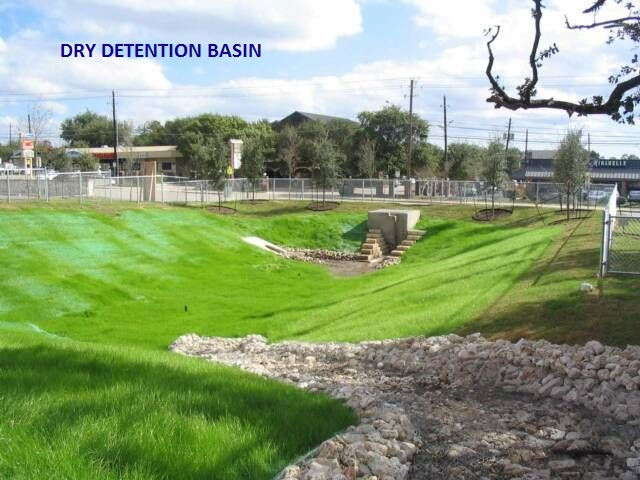Importance of Retention and Detention Ponds in Texas Water Management
- JRH Engineering & Environmental Services, Inc.
- Jul 17, 2023
- 3 min read

Purpose of Retention Ponds
Retention ponds, also known as "wet ponds" or "detention basins," serve as temporary reservoirs for stormwater runoff. The primary purpose of a retention pond is to retain or hold water during and after heavy rainfall events, gradually releasing it back into the environment over time. Unlike detention ponds, retention ponds have a permanent pool of water, which can support various aquatic ecosystems and enhance the aesthetic value of a community.
In Texas, where torrential rains and flash floods are common, the implementation of retention ponds has become essential in urban and suburban areas. By retaining stormwater runoff, these ponds help reduce the immediate impact of heavy rainfall, preventing flash flooding and potential damages to properties and infrastructure. Additionally, retention ponds aid in recharging groundwater resources, contributing to the sustainability of water supply in the region.
Purpose of Detention Ponds
Detention ponds, on the other hand, serve a distinct purpose from retention ponds. Instead of holding water indefinitely, detention ponds are designed to store stormwater temporarily, gradually releasing it at a controlled rate. The primary objective of detention ponds is to manage peak flows during intense rainfall events, regulating the discharge of water to prevent overwhelming drainage systems and natural waterways.
In Texas, the implementation of detention ponds is crucial for urban areas, where impervious surfaces like roads, parking lots, and buildings can lead to rapid stormwater runoff. Without proper management, this runoff can cause severe erosion, degrade water quality, and lead to destructive flash floods downstream. Detention ponds act as buffers, slowing down the flow of water and allowing sediment and pollutants to settle before releasing the water at a manageable rate.
Design and Construction of Ponds
The design and construction of retention and detention ponds are based on a thorough analysis of the catchment area, rainfall patterns, soil conditions, and water flow characteristics. Both types of ponds require careful consideration to ensure their effectiveness in managing stormwater.
Retention Ponds Design and Features
For retention ponds, the design typically includes a permanent pool of water with a defined storage volume to accommodate runoff from frequent rain events. The pond may have naturalized features, such as wetland vegetation, to support diverse wildlife and improve water quality. The outlet structure is carefully engineered to allow controlled release, preventing excessive flooding downstream.
Detention Ponds Design and Features
Detention ponds, on the other hand, are designed with a focus on temporarily storing and managing peak flows. Engineers calculate the required storage volume based on the catchment area, the desired flow rate, and the potential downstream impacts. Detention ponds often have an extended dry period between storms, allowing them to dry out completely before the next rainfall event.
Benefits and Environmental Impact
Flood Mitigation and Property Protection
Retention and detention ponds significantly reduce the risk of flooding during heavy rainfalls, protecting properties, roadways, and other infrastructure. By holding or slowing down stormwater runoff, these ponds allow the natural drainage system to cope with the increased flow gradually.
Enhanced Water Quality
Both retention and detention ponds play a crucial role in improving water quality. As water is held or detained, suspended sediment and pollutants settle out, leading to cleaner water discharged downstream. This helps protect local water bodies from pollution and preserves the natural aquatic ecosystems.
Support for Aquatic Life
Retention ponds, with their permanent water pools, offer unique opportunities to support aquatic habitats and enhance biodiversity. Wetland vegetation in retention ponds provides habitat for various plant and animal species, contributing to the overall ecological balance.
Groundwater Replenishment
In Texas, where water resources are often stressed, retention ponds aid in recharging groundwater supplies. By capturing stormwater runoff and allowing it to infiltrate the ground, these ponds help replenish aquifers and maintain a sustainable water supply.
Aesthetics and Recreational Opportunities
Well-designed retention ponds can serve as aesthetically pleasing elements in communities, enhancing the overall environment. These water bodies often become focal points for recreational activities, offering opportunities for fishing, bird-watching, and other leisure pursuits.
Conclusion
Retention and detention ponds play integral roles in managing stormwater and mitigating flood risks in Texas. By capturing and controlling stormwater runoff, these engineered structures help protect properties, improve water quality, and support aquatic ecosystems. In addition to their functional benefits, retention ponds contribute to groundwater recharge and offer recreational opportunities. Detention ponds, on the other hand, regulate peak flows, preventing flash floods and erosion downstream.
The implementation of these water management structures requires careful planning, design, and ongoing maintenance to ensure their long-term effectiveness. As climate change and urban development continue to impact water patterns in Texas, retention and detention ponds will remain essential tools in mitigating flood risks and safeguarding water resources and communities across the state.

Comments